By Jeffrey A. Rendall, Images Courtesy of Titleist.com
CARLSBAD, CA -- It's been over two years since I first played a Bob Vokey designed sand wedge, and it's been nearly as long since I've considered trying a different one. But recently, Titleist announced an entire new line of Vokey wedges -- and instead of the standard chrome or raw finish, these new clubs introduced more of a 'copper' look, or as they described it, an 'oil can' finish.
Vokey explains it this way: "The new Oil Can series comes directly from several years of experimenting with different oxidized finishes on the PGA Tour. The Oil Can finish provides a softer, more muted look, and is the perfect complement to the traditional Vokey Design Chrome appearance. The darker finish makes the club look slightly more compact at address, an attribute that provides added confidence with players."
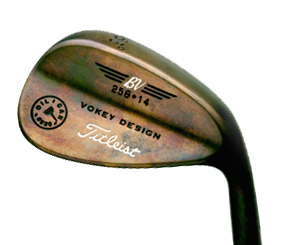 |
| The new 'Oil Can' finish. |
Vokey 'knows' confidence, since he's worked with many of the game's great players on their wedge preferences for many years. "I'm not a genius or anything, but I was fortunate during my early days to work with some very good sand players, namely Lee Trevino, Mark O'Meara, Dave Stockton -- good sand players. I've always been a good note taker and a good listener, and incorporated what I've learned into what I make."
"Tour players are very picky -- and precise. So I've taken their suggestions, and do what I call 'tweaking' to get their wedges to where they want them to be. Along the way, I've picked up some tips to make wedges for everyday players that are very useful in their games too."
The things Bob Vokey looks for in a wedge are bounce and sole width (flange) -- I never knew it was so complicated. Vokey continues, "I always look for profile -- make a wedge look good. Then you build in your design characteristics. That's why at Titleist there's a 200 series, a 300 series and a 400 series. Gives it a range. The 200 is for what I call my 'under forty crowd,' and the 300 and 400 is for the 'over 40 crowd.'"
Then he got technical: "Bounce angle is defined as -- the distance between the leading edge of the blade and the trailing edge of the blade. The way I look at bounce -- it's almost like the rudder on a ship. You turn sideways, and what it does -- it keeps the trailing edge a little lower than the leading edge so the club just glides through the sand, turf, or any other conditions."
 |
| Mike Weir saved all those pars at The Masters utilizing Vokey-designed wedges. |
"And there's an angle, which is called degree. If there's a little more bounce (and higher degree), then it would go into the sand or other playing conditions and come out a little quicker. If there's a little less bounce, then you'll have more luck with tighter lies."
"You try to come up with a combination of both (loft and bounce). That's why, in the series, I've worked with different formulas to come up with models with a little less bounce, and others with a little more bounce to give players the option -- to take the wedge they need for their particular course."
Vokey's also experimented with different aesthetic looks, which led to products such as the 'Oil Can' Finish, as well as the brand new 'Black Nickel' finish, both of which are available in the 200 Series lines. All Vokey wedges are cast from 8620 Mild Carbon Steel, which provides the 'softness' in feel you'll experience when using them. You're probably not going to carry a periodic table around with you when playing golf, but whatever elemental 'stuff' is added to these wedges, it works.
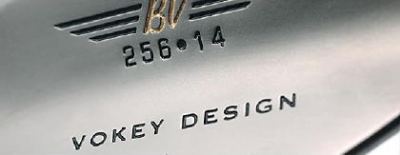 |
| The 'Oil Can' finish is new, but the 'Black Nickel' is even newer. |
The ball comes off very softly from a Vokey wedge -- and not just from the sand. Most of your better players today use sand wedges for the majority of chips and pitches, as well as short yardage full-swing shots. I personally use them for nearly all shots from 100 yards and in.
I've played Vokey's 258.12 and 252.08 models for the past two years, so I tried a couple slightly different wedges this time around -- with the Oil Can finish, the 256.14 (56 degrees loft, bounce of 14) sand wedge and a 260.08 lob wedge (60 degrees loft, bounce of 8).
I was surprised at each wedge's different performance characteristics from the previous models. As Vokey explained above, you'll use different wedges with different degrees and widths for different conditions -- that's certainly the truth.
Titleist says the 256.14 model is ideal for players with a steeper angle of attack. It has a slightly lower center of gravity, which makes it an excellent scoring wedge from deep rough and soft fairway or sand conditions. Likewise, the 260.08 model contains a slightly wider sole and increased bounce for playability. It's also recommended for deep grass or sand, and in softer course conditions.
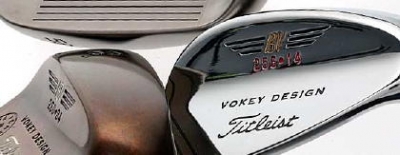 |
| Different looks, excellent playing characteristics. |
And for anyone who's played golf in the Mid-Atlantic region recently, 'soft' course conditions are pretty much standard -- so the individual club strengths would certainly match the playing conditions.
As a point of reference, I'd gotten quite used to playing my previous wedges in very specific circumstances. I used the 258.12 for sand shots and short chips from around the greens, while employing the 252.08 for full-swing shots from around 100 yards (as a 'gap' wedge), and for lengthier pitches around the greens. For any 'trouble' shots, I'd employ the 258 model, with basically good results.
I'd hesitated to use the 258 model for full-swing shots from fairways or tight lies, as I had a tendency to hit it thin or fat. Likewise, using the 252 model around the greens or from deeper bunkers didn't provide the same kind of performance that the higher lofted wedge offered.
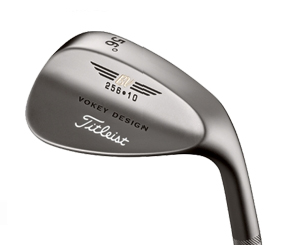 |
| The 'Black Nickel' finish. |
I basically found the shots for which I'd use the 258 wedge in the past, I'd employ the new 260 Oil Can wedge, with a minor difference. From tight lies, I preferred the 256 wedge, due to the fact I bladed several with the 260 while hitting from tight fairway or closely mown chipping areas. In contrast, the 256 wedge was very consistent from all types of lies. The 260 wedge was a steady performer from sand, a slight improvement from the older models. I noticed a few yards difference between the 256 model and the 252 model when hitting from the fairway -- as you'd expect from utilizing 4 degrees less loft.
The 260 model was outstanding when extricating myself from bad lies -- and for this early in the season, there've been many opportunities for it to work its magic.
Vokey said too much bounce for certain playing conditions can be a problem, and that helps explain the differing results: "These particular wedges are designed for soft conditions, soft dirt, sand, or turf conditions. Where in other words you won't dig as much. In contrast, if you have too much bounce in firm conditions, you'll end up bouncing to the back of the palm -- your trailing edge hits first and the leading edge is a little higher on the ball -- and that's called a blade or a skulling." He suggested using models with less bounce for firmer lies.
Sounds like you can use a whole closet full of Vokey wedges, then pick and choose based on your course conditions on that day! The days of owning only one wedge are gone -- especially if you're demanding high performance on different courses and conditions.
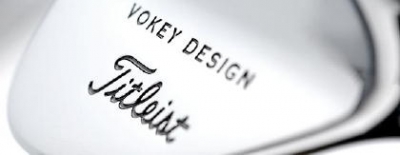 |
| 'Chrome' is probably how you're used to seeing Vokey wedges. |
Vokey explains how he'd 'fit' a wedge for you: "For your higher handicapper, you'll probably go with a little more bounce, a little bit wider flange to keep him from 'digging in' -- because he's probably got a steeper swing. For your better player, he's a 'slider,' a shallow cut player, he likes to take it back and moves his arms and shoulders through the ball. He takes a firm enough and hard enough swing so that he takes just enough sand to splice the sand and pops the ball out -- he doesn't need as much bounce."
"Every individual is different, and this isn't a science. There're techniques involved too. Every club maker has his own technique. At Titleist, we try to provide variety -- enough of a variety of lofts, bounce and sole conditions -- because loft's another determining factor. For some courses -- if you've got pot bunkers, you're going to need a little bit more loft..."
Vokey clearly knows what he's doing. He's had the practice, the feedback, and the experience to get it right. And now he's even introduced some different 'looks' into his creations, to give you the choice on what appears best to your individual, discerning eye.
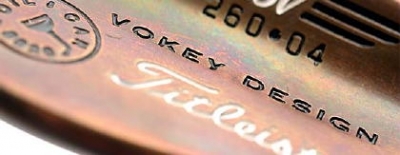 |
| The 'Oil Can' finish. |
He left me with one thought: "The perfect wedge doesn't exist. It's just not fair."
Well, with the accumulated scholarly learnings of the devoted sand wedge pupil, Bob Vokey's as close as they come to a real genius.
Details:
Titleist Vokey Design Wedges
Series Designer: Bob Vokey
200 Series; 300 Series; 400 Series. Varied Lofts and Bounces to suit playing conditions and styles of play, as well as four different finish choices – Chrome, Oil Can, Black Nickel & Raw.
Suggested Retail: $125 for Oil Can; $125 for Black Nickel; $115 for Chrome; $125 for Raw Finish. Available at Fine Pro Shops and Golf Retail Stores.
Website: www.titleist.com/wedges/default.asp
For a look at Titleist's Scotty Cameron Studio Design Putters, click here.
| Related Links | Comments on this article? | |
|
Maryland National Golf Club Hollow Creek Golf Club Rocky Gap Resort PB Dye Golf Club in Ijamsville Whiskey Creek Golf Club |
E-mail Jeff Rendall, Editor: jrendall@golftheunitedstates.com |











